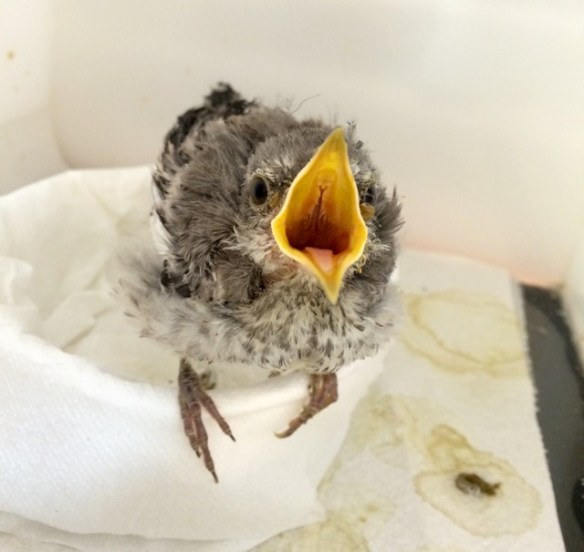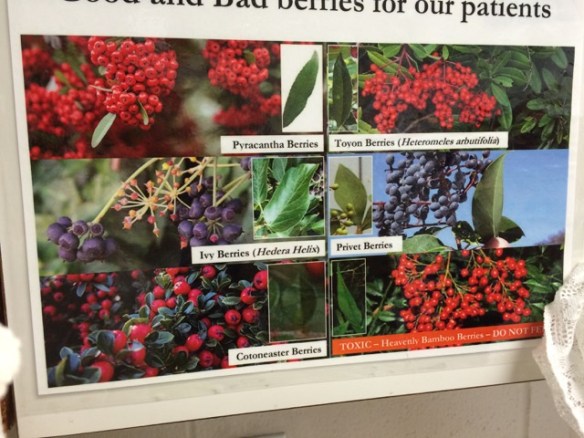
Orphaned nestling American Robin, hungry.
It’s adorable, and it needs you. That’s an incredibly potent combination, and it does not make you want to take the animal to some strangers and leave it in their clinically-gloved hands. You have food, you have water—surely you can take care of this lost wild creature just as well as some rehabilitators, and with more love, too!
The problem here isn’t just the things you don’t know about wild animal care—it’s the things you don’t know that you don’t know. You will be a bad caretaker for this animal, no matter how much you love it, because you won’t know the things it may need. If you haven’t been inside a wildlife rehab facility, it’s hard to appreciate all the things that they do that your average person simply doesn’t have the knowledge or resources for.
Based on my experiences volunteering at a wildlife rehabilitation hospital, here are a few of the things that a wildlife rehabilitator may be able to do for that wild animal you just found.
Supportive medical care
A quick dose of pain medication will rapidly reduce the animal’s anxiety and suffering. Administration of subcutaneous fluids helps dehydrated animals feel immediately better. Even if apparently administered dispassionately (although trust me, the vets and vet techs do care deeply about the animals), these treatments are love the animal can feel.
Critical medical care
A broken wing or leg, if set and treated properly, can heal and leave the animal as good as new. This is not a simple thing to accomplish, however—you will not be able to watch a Youtube video and then perfectly treat that owl’s wing. A flesh wound can heal, or it can fester and kill the animal slowly. Do you have access to a veterinarian’s repository of knowledge, specialized bandages, and medications that allow them to treat these wounds safely and with a minimum of pain?
What if there isn’t obvious injury? Maybe the animal isn’t injured—or maybe you can’t see it. Are you sure you can tell the difference between (minor) wing strain and (major) wing dislocation? The vet can – and if she can’t feel it with her practiced fingers, she may be able to take x-rays.
If your cat brought the animal in, you’d better be certain that the cat didn’t break the skin anywhere; cat’s mouths are full of bacteria, and an untreated animal with a cat-caught infection can go from just fine to dead in 12 hours. The wildlife rehabilitators can comb over every centimeter of the animal’s skin to be sure, and if in doubt, they can give the animal appropriate antibiotics to protect it from those deadly infections. (And no, you can’t just give the animal some human antibiotics you have lying around.)

A minor example of the detailed, species-specific knowledge wildlife rehabbers have access to: a guide to perch sizes for various species.
Protecting the animal from itself
Injured mammals may chew at their own wounds. Anxious raptors can injure themselves with their own talons. Do you know how to bandage them so that they won’t do that? You can’t just restrain the animal—that might cause them to lose flexibility or function in the restrained body parts.
Feeding the animal what it needs
Young or sick animals are extremely dependant on getting the right diet.You may think you know what animals eat – raptors eat meat, baby birds eat worms – but it’s so much more complicated than that. Young finches need different nutrition than young sparrows. Young doves must be tube-fed a specialized dove formula. An injured adult opposum or raptor may need a whole dead mouse, a dead mouse without its guts, a skinned dead mouse, or something else entirely. How much calcium does the animal need? Get that wrong, and its bones may grow in fragile and prone to breaking. Does the animal have a jaw injury that necessitates soft food? Are you sure?

Can you tell these berries apart? Do you know which birds should get berries? Note the berries in the bottom right that are toxic.
The animal hospital has had people bring in hummingbirds that they have fed Red Bull, bread, and spaghetti. Maybe you won’t make such a wild mistake—but the people who did those things didn’t know they were mistakes. They thought they were helping.
Feeding the animal the right amount, the right way
Getting the food right is only half the battle; you also have to get it into the animal. Baby birds seem like they ought to be easy: they open their bills, flutter their wings, and cry “Feed me!” That’s straightforward, right? But some birds won’t open their bills even when hungry, unless you know the tricks; towhees, for example, will stubbornly watch you try to feed them even when they are hungry, and only relent if you apply the right combination of syringe movements and sheer persistence. Other birds will beg even when full, and if fed every time they beg, they can become so overfed that they die.
Just to make things more fun, the syrinx of a bird—which leads to its lungs—opens in its throat; stick your syringe in the wrong place and you can drown your bird.
________________________________________________________
This is just a taste of the issues, not a comprehensive list. It isn’t meant to make you feel guilty or inadequate; it is, frankly, just information I wish I had known a long time ago. I have made a number of baby-animal rehabilitation attempts in the past; some of them were successful, some of them weren’t. I wish I had known then how much I didn’t know, and what I was doing to these animals by not finding them a licensed wildlife rehabilitator. I now know the best thing I can do for any orphaned or injured wildlife is to take them to the experts.
If you want to learn more, find out if there is a rehabilitator near you who accepts volunteers. It’s a fascinating, messy, occasionally heart-rending experience that I highly recommend.
If you have found an animal and don’t know what to do, many rehabilitators have hotlines you can call with questions. The Lindsay Wildlife webpage and Wildcare webpage have hotline numbers, advice, and links to other resources.

Pingback: What to do if you find a baby bird; plus, baby Steller’s Jay | Tough Little Birds
Nice article
On my I feel I should give taken it to a very so much now